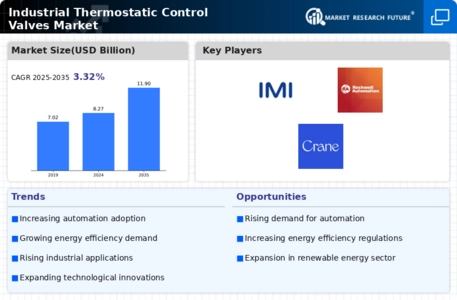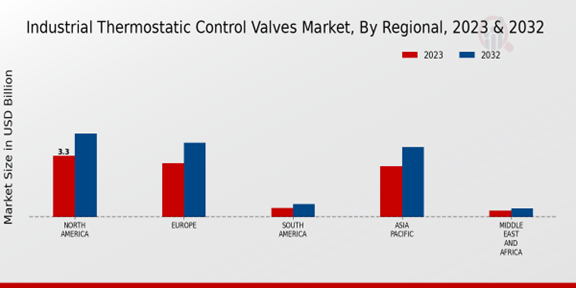Market Growth Projections
The Global Industrial Thermostatic Control Valves Market Industry is poised for substantial growth, with projections indicating a market size of 8.27 USD Billion in 2024 and an anticipated increase to 11.9 USD Billion by 2035. This growth trajectory reflects a compound annual growth rate of 3.32 percent from 2025 to 2035. The increasing adoption of thermostatic control valves across various sectors, driven by the need for energy efficiency, technological advancements, and regulatory support, suggests a robust market outlook. These figures highlight the potential for investment and innovation within the industry.
Rising Demand for Energy Efficiency
The Global Industrial Thermostatic Control Valves Market Industry is experiencing a notable increase in demand for energy-efficient solutions. Industries are increasingly adopting thermostatic control valves to optimize energy consumption and reduce operational costs. For instance, the integration of these valves in HVAC systems can lead to energy savings of up to 30 percent. As organizations strive to meet sustainability goals, the market is projected to reach 8.27 USD Billion in 2024, reflecting a growing trend towards energy-efficient technologies. This shift not only enhances operational efficiency but also aligns with global initiatives aimed at reducing carbon footprints.
Increased Focus on Process Optimization
There is a growing emphasis on process optimization across various industries, which is positively impacting the Global Industrial Thermostatic Control Valves Market Industry. Companies are increasingly looking for ways to enhance their operational processes, reduce waste, and improve overall efficiency. Thermostatic control valves are integral to achieving these objectives, as they provide precise temperature regulation, thereby optimizing production processes. This focus on efficiency is likely to drive market growth, as industries recognize the value of investing in advanced control technologies to streamline operations and reduce costs.
Growth in the Chemical Processing Sector
The chemical processing sector is a significant driver for the Global Industrial Thermostatic Control Valves Market Industry. As the demand for chemicals continues to rise, the need for efficient temperature control systems becomes increasingly critical. Thermostatic control valves play a vital role in maintaining optimal process conditions, ensuring product quality and safety. The expansion of chemical manufacturing facilities globally is expected to bolster the market, with industries seeking reliable solutions to manage temperature fluctuations. This trend underscores the importance of thermostatic control valves in enhancing operational efficiency within the chemical sector.
Technological Advancements in Valve Design
Innovations in valve technology are driving growth in the Global Industrial Thermostatic Control Valves Market Industry. Advanced materials and smart technologies are being integrated into valve designs, enhancing their performance and reliability. For example, the development of electronically actuated thermostatic valves allows for precise temperature control, which is crucial in various industrial applications. This technological evolution is expected to contribute to the market's expansion, with projections indicating a rise to 11.9 USD Billion by 2035. The continuous improvement in valve design not only meets the increasing demands of industries but also enhances system efficiency.
Regulatory Support for Industrial Automation
The Global Industrial Thermostatic Control Valves Market Industry benefits from supportive regulatory frameworks promoting industrial automation. Governments worldwide are implementing policies that encourage the adoption of automated systems, which often incorporate thermostatic control valves. These regulations aim to enhance productivity and safety across various sectors, including manufacturing and energy. As a result, the market is likely to witness a steady growth trajectory, with a projected CAGR of 3.32 percent from 2025 to 2035. This regulatory environment fosters innovation and investment in advanced control systems, further driving the demand for thermostatic control valves.



 Source: Primary Research, Secondary Research, Market Research Future Database and Analyst Review
Source: Primary Research, Secondary Research, Market Research Future Database and Analyst Review









